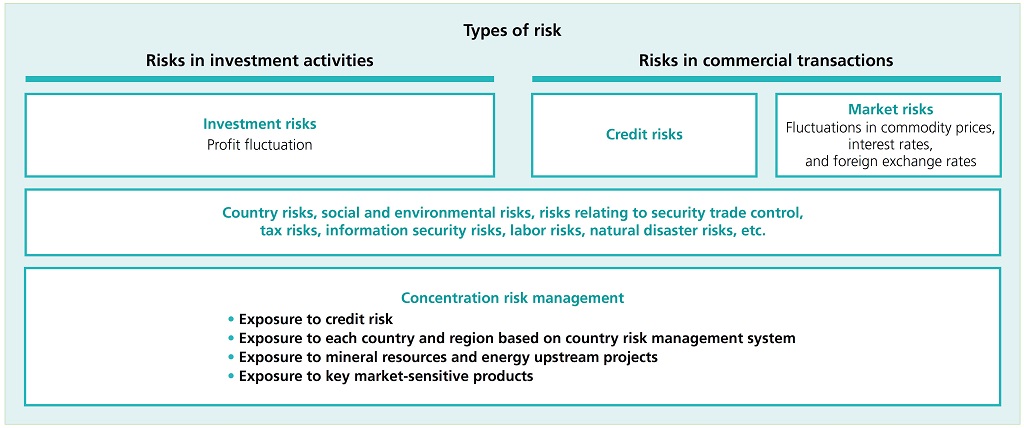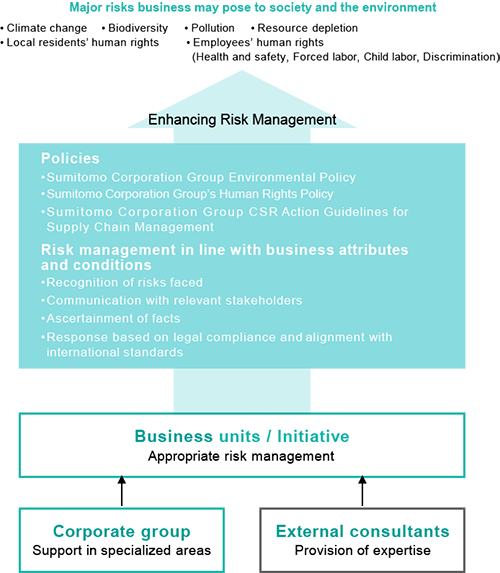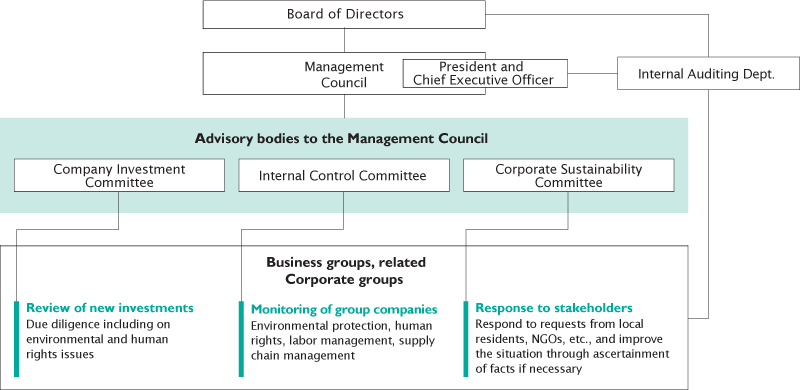View Sumitomo Corporation's Sustainability : Risk Management
We define “risk” as “the possibility of losses due to the occurrence of anticipated or unanticipated situations,” and also as “the possibility of not achieving the expected return on business activities.” We have set the following three items as the goals of our risk management activities.
We categorize our business activities into investments and commercial transactions, identify both common and category-specific risk factors and analyze and evaluate probability and impact of the risk factors. By actively introducing advanced methods and processes, we have created an effective risk management framework that anticipates changes in the external environment.
Our goal is to implement the best practice in risk management while maintaining the flexibility to adapt to changes in the business environment. The business environment is continually altering, and new business models that we could never have imagined are emerging on a daily basis. To respond to this situation in a timely and effective manner, we are working to evolve our risk management activities under the leadership of senior management.
As an example, we have established rigorous investment discipline as the common basis of judgment for selecting more appropriate investments among diverse investment opportunities in a wide range of business domains. At the same time, we have established an optimal governance system for increasing the value of each business after investment and introduced an incentive plan linked to investment performance.

Taking into account the changes in the overall portfolio and the nature of the risks involved in each individual investment opportunities, we have adopted a unified management framework that covers everything from the entrance to the exit of the investment, while reviewing the process for assessing and following up on investment projects as appropriate.
When assessing investment projects, we clarify the “investment theme” from the initial stage of the process and focus on verifying its appropriateness as a key point of due diligence. In addition, by applying a discount rate appropriate to the risk of the businesses, we calculate the “appropriate price” of the investment target and evaluate the opportunity from both quantitative and qualitative aspects.
Depending on the scale and importance of the project, decisions on investment matters at each stage of consideration and execution are made at meetings of the Company’s Management Council and its advisory body, the Company Investment Committee, or the Group Management Council, which is a decision-making body in each Business Group. From an early stage, these institutions conduct in-depth discussions from a variety of perspectives on the various factors that may affect the success or failure of investments, such as strategic positioning of the project, background to and reasoning behind project selection, assumptions and certainty of post-investment value-enhancement measures, and ESG issues.
In addition, we have enhanced the mechanisms for improving the probability of investment success at each investment stage. We will increase the value of each business by steadily implementing measures, including the establishment of strict investment discipline for selecting investments, the development of an optimal governance system for increasing the value of each business after investment, the review of strategies and the formulation of medium-term plans for addressing changes in the external environment, and the timely and appropriate investment of resources. Furthermore, to increase our commitment to value enhancement, we introduced a new compensation system linked to the investment performance in 2022. Strengthening our monitoring efforts, we set a clear timeline for business investments that do not increase in value as expected and implement improvement measures. We will continue to thoroughly replace assets where improvement is not materialized as planned.
The Sumitomo Corporation Group operates businesses dealing in different products and business models in various regions of the world and its business activities have a variety of impacts on the global environment and on different stakeholders such as local communities, business partners, and our officers and employees. To achieve sustainable growth together with society, we work to control the social and environmental impacts of each business of the Group, and, by monitoring its entire supply chain, to ensure that the impact of the associated business activities is not a threat to people’s lives or the global environment and does not constrict the sustainability of our management. As the basis for these initiatives, we have established Environmental Policy, Human Rights Policy and CSR Action Guidelines for Supply Chain Management to clarify our approach to social and environmental issues in the Group’s business operation. Because the impact of each business on society and the environment and the nature of the risks requiring management focus differ depending on the products dealt with, the business type and the region where it operates, risk management needs to be adapted to the specific character of the business. Specifically, for each of our businesses, we obtain the relevant data, including information on its interface with society and the environment and the associated risks. In addition, we ascertain whether serious issues are present by maintaining communication channels with local communities, employees, and other stakeholders, and check not only that the business is legally compliant across the range of social and environmental issues but also that its response in the area complies with international standards on the environment and human rights. Within the Sumitomo Corporation Group and its diverse range of businesses, the responsible business department of individual businesses and the related corporate departments are working jointly to raise the standard of social and environmental risk management groupwide, utilizing the knowledge of outside experts.

The Sumitomo Corporation Group has established a companywide framework to perform appropriate monitoring of the social and environmental impact of the Group’s entire business activities. When we conduct business due diligence of new investments, we also asses both environmental and social risks associated with the business. To enhance the efficiency of the risk management process, we have prepared a self-assessment sheet that includes risk information described in SASB standards and other sources on relevant social and environmental risks to be used at the time of investment application to identify anticipated risks and opportunities with respect to the nature and regional characteristics of each business. Our decision-making mechanism in Company Investment Committee then takes into account impacts on society and the environment. As follow-up to the investment, the responsible business department and related corporate departments work together through dialogue with group companies to carry out regular monitoring from the viewpoint of the environment, human rights, labor management, the supply chain, and other aspects. If an issue arises, remedial action is taken in line with the specifics of the case. Internal audits that take into account special characteristics of the business are used to confirm that management operations are legally compliant and meet international standards on social and environmental issues. When a case relating to the impact of the Sumitomo Corporation Group’s business activities is referred to by a local community, a non-governmental organization (NGO), or another stakeholder, we ascertain the facts and engage in dialogue and discussion toward improvement. In addition, we have enhanced our engagement activities through dialogue with stakeholders and rights holders of our material businesses with respect to social and environmental risks. If, as a result of this process of review and monitoring of investments, an important social or environmental risk is confirmed, we actively consider appropriate responses, based on advice from external specialists if necessary, and the individual response is reported or referred for further discussion to the Management Council and the Board of Directors through the relevant internal committees.
